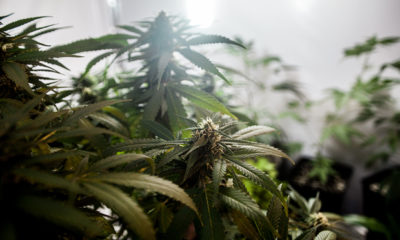
Economics
As Alaskan Oil Plummets, Pot Futures Are Bright
Alaska’s money managers are facing a mounting crisis this year as crude oil prices continue to tumble to unsustainable lows. According to the Alaska Oil and Gas Association, oil prices have fallen steadily since summer 2014, dropping from more than $100 a barrel for Alaskan crude oil to $30.63 in February. The state, which for 35 years has had neither sales nor income tax and until just recently was able to pay for 90 percent of its operating costs with oil and gas revenues, is sliding into the black void of an upcoming budget shortfall of more than $5.2 billion.
At the same time, legal recreational cannabis sales are on course to bring in a positive revenue flow that is expected to continue a steady progression into the red, and could perhaps eventually be one of the key local resources that helps buoy the state’s economy along with tourism and local fisheries.
The Land of the Midnight Sun – one of the most oil-dependent regions in the world – has for the past 40 years been so well off that is has provided all residents of Alaska with an annual dividend check simply for living in the state. Last year’s payment amount was for more than $2,000 and went to ever man, woman and child, provided from the “permanent fund dividend” now worth upwards of $50 billion. And while state law requires that the money cannot be touched – only the earnings on the primary fund, which are currently at $10 billion – some are worried that lawmakers may decide to poach some of the permanent fund money to pay off the looming monster debt.
Says Sen. Bill Wielechowski in an interview with NPR, remarking that before the state goes after Alaskans’ permanent fund dividend it should perhaps demand more of the monolithic oil industry. “I have a hard time going back to my constituents and saying, ‘Yeah, I’m sorry, I have to take your [permanent fund dividend] so I can continue to give tax credits to the largest, wealthiest corporations in the history of the world.’ That’s not going to fly in my district.”
Some believe that the emerging cannabis industry – like the fisheries and tourism industries that came before them – is in a position to one day be just the relief that Alaskans need. A report released by the Marijuana Policy Group (MPG), an impartial research organization, notes that assuming the pre-tax retail price is similar to Colorado’s during their initial year at $14 per gram, “the [Alaska]-wide value of first-year sales would be $55.6 million and rising to $106.9 million by 2020.”
While MPG notes that the revenue amount may appear to be a long way from filling the multi-billion-dollar budget shortfall that dropping oil prices have created, they add that “still the revenues from legal cannabis will undoubtedly be a steady stream of cash that keeps policymakers’ hands off of the average Alaskans permanent fund dividends.”
The taxes from $55-$106 million in legal pot revenues could make a difference, for instance, in the current situation the government finds itself. Alaskan Gov. Bill Walker has proposed to cut 185 jobs in the next fiscal year, beginning July 1. The governor’s proposal, which the International Business Times says includes a net reduction of about $100 million in state spending from the current budget, also proposes to “reinstate the income tax, slap a hefty tax on alcohol, in a state where alcohol taxes are already among the nation’s highest, boost taxes on fuel and cap the permanent fund dividend at $1,000.”
Pro-cannabis activist Adele Tara – co-founder of Alaska Green Angels, a non-profit organization in Anchorage that gives out medical marijuana free of charge to the severely ill and veterans – believes the cannabis industry has the potential to make significant profits that could eventually take the place of the flagging oil and gas makers.
“If Alaska approaches the cannabis industry in the correct manner,” says Tara, “promoting cannabis tourism from neighboring countries like Russia and Japan, over time Alaska could easily become the Amsterdam of the U.S. for cannabis tourism. Also given that Alaska’s year-round outdoor activities far exceed the opportunities available in places like Denver.”
Cannabis cultivator and pro-cannabis activist James Barrett, co-founder of Rainforest Farms in Juneau, is in the process of applying for the three state licenses for cultivation, processing and retail. “Having these three licenses allows us to grow cannabis, create products such as edibles and other infused items, and then sell the products in our café,” says Barrett.
Because the state will allow for onsite consumption of cannabis in retails stores – unlike the other recreationally legal states of Colorado, Washington and Oregon – Alaskan regulations may pave the way for new revenues at locations like cannabis cafes and clubs. Planning to make the most of his business opportunities, Barrett continues, “In addition to the on-site cannabis consumption endorsement, we can also serve food, drinks and other non-cannabis related products.”
As with other states that have legalized pot, it’s up for debate what the numbers will look like until the industry gains momentum. The future could possibly show Alaskans getting yearly dividend checks for weed instead of oil. It’s not out of the question, considering the enviable position Colorado found itself confronted with in 2013 with excess revenues that meant paying money back money to its citizens.
Says Barrett, “Alaska will now have a new source of revenue that, although may not immediately bring in the type of revenue that oil does, it will be a state regulated industry that will not only bring in tax revenue, but will stimulate local economies as well.”
Do you plan to enjoy cannabis tourism in Alaska this year?
























